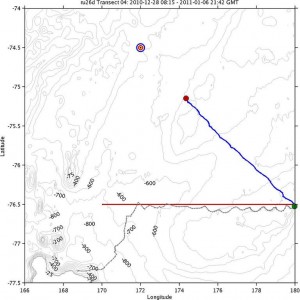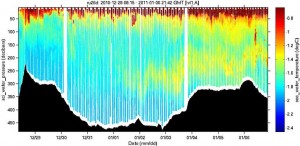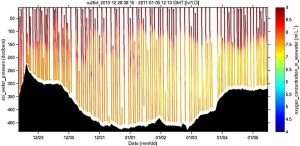Bank To Bank
We are now halfway through this important transect across the Ross Shelf. The glider is telling us about the conditions and how they change as we move from one bank to the next. In the map below you can see the location of the glider indicated by the red dot and the start of this transect shown as a green dot. This first half of the leg takes us from Ross Bank to the south east and Pennell Bank to the north west. All the data I talk about below was collected between the red and green dots.
These banks are regions of shallower water that separate the areas of deeper water. The troughs in the topography are regions where we expect to find the Modified Circumpolar Deep Water (MCDW) water we are looking for. The specific mass of water we call MCDW has features that will allow us to identify it. It is characterized by a sub-surface peak in temperature and low dissolved oxygen. The glider has sensors that continuously measure the water temperature and dissolved oxygen that we can use to identify this MCDW.
The plot above shows the water temperature from the sea surface on the top to the seafloor on the bottom along the transect. The x-axis of the plot is time and the y axis is the depth of the water. The color indicates the temperature, with warmer values shown as red and colder values shown as blue. If you ask me it should all be blue, look how cold this water is! On this plot you can clearly see the shallow water associated with Ross Bank on the left and Pennell Bank on the right. The warmest water is near the surface where the sun has been beating down since the ice began to melt in November. As you move deeper down in the water you can see the water quickly cools. Over Ross Bank this cooling continues all the way to the bottom. However on the right near Pennell Bank we see a region in the water column where the water actually gets warmer again. This is seen as the band of yellow starting around January 1st. This warm water, centered 300 meters deep over the trough and 200 meters deep over the bank could be the MCDW we are looking for. We need to look at all the information gathered by glider to test the other criteria that describe MCDW.
The dissolved oxygen provides another clue on the source of this warmer water. In addition to warmer temperatures, MCDW is characterized by low dissolved oxygen. In the plot above the color now represents dissolved oxygen. The red color near the surface indicates higher concentration fueled by the presence of phytoplankton and exchange with the atmosphere. While there is lower dissolved oxygen deeper down and even over Pennell Bank, it is not conclusive enough to confidently call this warmer water MCDW. We need to see how the temperature and oxygen data look as the glider continues across the shelf and down the next trough to be sure we have MCDW.
With each surfacing of the glider we learn more about this remote part of our ocean!


 January 6, 2011
January 6, 2011 










2 Responses to “Bank To Bank”